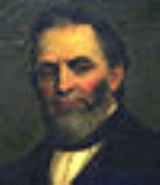
Chandler J. Wells
Encyclopedia
Chandler J. "Chan" Wells (1814–1887) was Mayor
of the City of Buffalo, New York
, serving 1866–1867. He was born in Utica, New York on June 10, 1814, where his mother had gone to recuperate, while Buffalo was being rebuilt after the December 1813 burning. Not long after that they returned to Buffalo. He became a joiner's apprentice and found employment with Benjamin Rathbun. On April 20, 1837, he married Susan Jane Wheeler. He then worked as a contractor and builder and at one time owned three saw-mills around western New York. Around 1857, Wells became interested in buildings grain elevators and constructed the "Wells Elevator," later known as the "Wheeler Elevator." He later constructed other grain elevators at Buffalo.
In 1854, Wells was elected to his first public office, as alderman
for the second ward. He held that office continuously until 1859. He was elected mayor on November 7, 1865, as the Republican
candidate. In September 1866, Mayor Wells received General Ulysses Grant, President Andrew Johnson
, and members of his cabinet on their visit to Buffalo. The Fenian uprising also occurred during 1866, with thousands of Fenians gathering in Buffalo. He did not seek a second term in office.
After his term, in 1868, he was appointed to the Board of Water Commissioners and oversaw construction of the water inlet pier in the Niagara River
. In 1870, Wells began importing sand for paving and building purposes from property purchased at Point Abino on Lake Erie
He died on February 4, 1887, and is buried in Forest Lawn Cemetery
.
Mayor
In many countries, a Mayor is the highest ranking officer in the municipal government of a town or a large urban city....
of the City of Buffalo, New York
Buffalo, New York
Buffalo is the second most populous city in the state of New York, after New York City. Located in Western New York on the eastern shores of Lake Erie and at the head of the Niagara River across from Fort Erie, Ontario, Buffalo is the seat of Erie County and the principal city of the...
, serving 1866–1867. He was born in Utica, New York on June 10, 1814, where his mother had gone to recuperate, while Buffalo was being rebuilt after the December 1813 burning. Not long after that they returned to Buffalo. He became a joiner's apprentice and found employment with Benjamin Rathbun. On April 20, 1837, he married Susan Jane Wheeler. He then worked as a contractor and builder and at one time owned three saw-mills around western New York. Around 1857, Wells became interested in buildings grain elevators and constructed the "Wells Elevator," later known as the "Wheeler Elevator." He later constructed other grain elevators at Buffalo.
In 1854, Wells was elected to his first public office, as alderman
Alderman
An alderman is a member of a municipal assembly or council in many jurisdictions founded upon English law. The term may be titular, denoting a high-ranking member of a borough or county council, a council member chosen by the elected members themselves rather than by popular vote, or a council...
for the second ward. He held that office continuously until 1859. He was elected mayor on November 7, 1865, as the Republican
Republican Party (United States)
The Republican Party is one of the two major contemporary political parties in the United States, along with the Democratic Party. Founded by anti-slavery expansion activists in 1854, it is often called the GOP . The party's platform generally reflects American conservatism in the U.S...
candidate. In September 1866, Mayor Wells received General Ulysses Grant, President Andrew Johnson
Andrew Johnson
Andrew Johnson was the 17th President of the United States . As Vice-President of the United States in 1865, he succeeded Abraham Lincoln following the latter's assassination. Johnson then presided over the initial and contentious Reconstruction era of the United States following the American...
, and members of his cabinet on their visit to Buffalo. The Fenian uprising also occurred during 1866, with thousands of Fenians gathering in Buffalo. He did not seek a second term in office.
After his term, in 1868, he was appointed to the Board of Water Commissioners and oversaw construction of the water inlet pier in the Niagara River
Niagara River
The Niagara River flows north from Lake Erie to Lake Ontario. It forms part of the border between the Province of Ontario in Canada and New York State in the United States. There are differing theories as to the origin of the name of the river...
. In 1870, Wells began importing sand for paving and building purposes from property purchased at Point Abino on Lake Erie
Lake Erie
Lake Erie is the fourth largest lake of the five Great Lakes in North America, and the tenth largest globally. It is the southernmost, shallowest, and smallest by volume of the Great Lakes and therefore also has the shortest average water residence time. It is bounded on the north by the...
He died on February 4, 1887, and is buried in Forest Lawn Cemetery
Forest Lawn Cemetery, Buffalo
Forest Lawn Cemetery in Buffalo, New York was founded in 1849 by Charles E. Clark. It covers over 250 acres and over 152,000 are buried there. Notable graves include U.S. President Millard Fillmore, singer Rick James, and inventor Lawrence Dale Bell...
.

